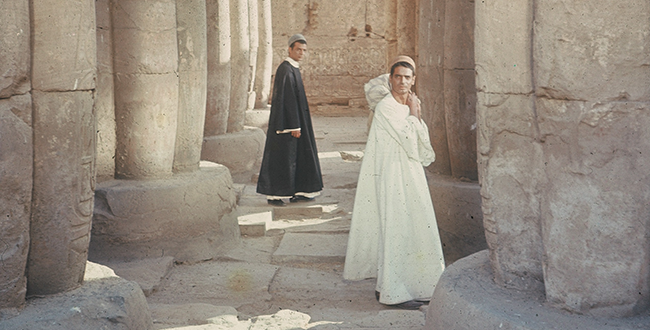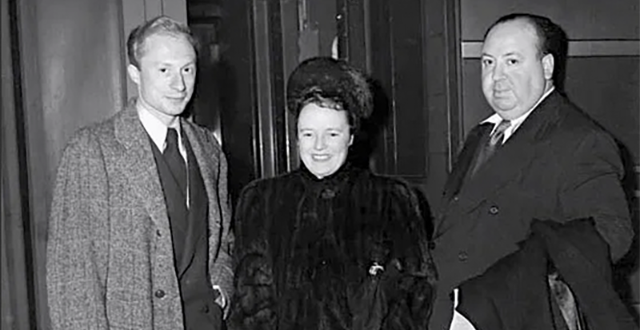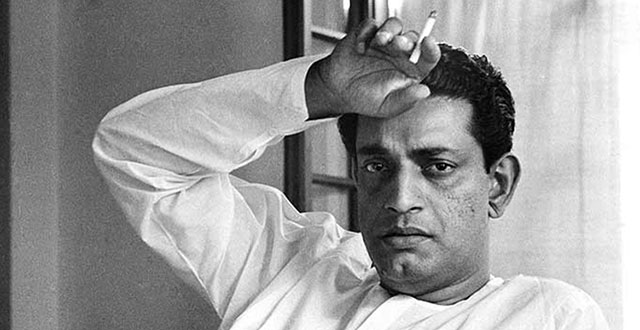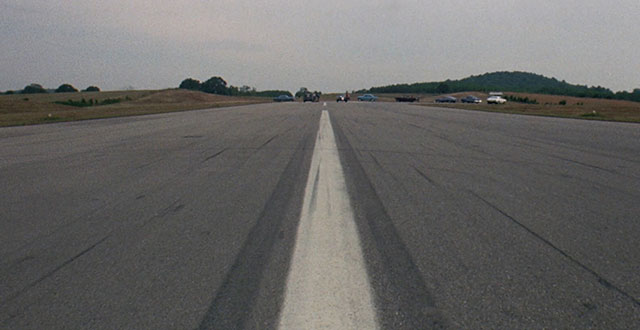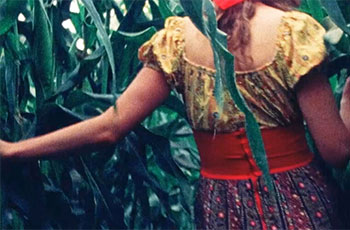News
NOTES ON FILM & RESTORATION
There is a story told of the Baal Shem Tov, with which Elie Wiesel prefaced his novel The Gates of the Forest. Whenever there was trouble coming for the Jewish people, the great Rabbi would go to a particular part of the forest to meditate, light a fire, and say a special prayer that would avert looming disaster. After the Rabbi was gone, his disciple saw trouble coming again. He knew the place in the forest, he knew the prayer, but he’d forgotten how to light the fire, but his prayer was answered. Another interval of time, the disciple of the previous disciple, more trouble on the horizon: he’d forgotten the prayer, he didn’t know how to light the fire, but he knew the place in the forest, and disaster was again averted. And still later, his disciple saw looming disaster once again: he didn’t know how to light the fire, he didn’t know the prayer, and he didn’t know where the place in the forest was…but he knew the story. And that was enough to avert disaster once again.
I thought of this story when I was reflecting on the situation in which we now find ourselves with film exhibition. It’s a long, long road from the first Lumière screenings to where we are now, and there are many more generations and levels of forgetting than in the Baal Shem Tov story. The experience of going to the movies when I was young is to a millennial watching something—anything—on a streaming platform as the duck-billed platypus is to a plant-based sausage: you know that there’s some kind of relationship but you can’t articulate exactly what it is.
As cinema has been altered again and again by one business-driven decision after another, each of those decisions resulting in changes that have been deemed “inevitable,” every corner of cinema, from the quality of projection to the standards of film festivals to the level of discourse to the very idea of the art of cinema itself, has been affected by coarsening agents, and every new technological tool has been almost instantaneously packaged, sold and milked for every last penny. And as the years have gone by and the legal rights to film libraries have been passed from the control of one entity after another, each one governed by people further and further removed from any sense of cinema at all, the titles comprising those libraries have in turn been milked dry, and in turn “devalued,” to use Marty Scorsese’s term. Those of us who love the art form feel like followers of a faith seeing their sacred objects ransacked and sold for parts, like the young man in Shadi Abdel Salam’s Al Momia who discovers that his family has been looting the sarcophagi in a nearby tomb and selling the treasures on the black market.
This post is not about any one of the many titles in whose restoration The Film Foundation played a part. It’s about all of them, each restoration undertaken with care and love, each one receiving the kind of attention that the very art of cinema now needs from those who love it. There is not “they” to automatically swoop in and protect it. When films are unavailable, we all have to cry out until they’re made available again. When they’re presented in substandard or compromised conditions, we have to hammer away at it until they’re presented correctly. When theatres shut down, we have to let everyone know that we want them to re-open and then to go back when they do. Now, we’re the ones who have to keep the cinema alive. We have to remember, every day, the place in the forest, the prayer, and how to light the fire. Because I’m not sure if the story will be enough.
- Kent Jones
Follow us on Instagram, and Twitter!
AL MOMIA (Egypt, 1969, d. Shadi Abdel Salam)
Restored in 2009 by Cineteca di Bologna/L’Immagine Ritrovata laboratory, in association with The Film Foundation’s World Cinema Project, and the Egyptian Film Center. Restoration funded by Armani, Cartier, Qatar Airways, Qatar Museum Authority and the Egyptian Ministry of Culture.
NOTES ON FILM & RESTORATION
When I got the news that Norman Lloyd had passed away at the age of 106, I called my friend Bruce Goldstein. Bruce and Norman had become close over the years, and they talked once a week on the phone. “How much longer can he go on, I wondered,” said Bruce. “But still, I’m very sad.”
I was sad because Norman lived through all of that history and was ready, willing and absolutely able to transmit it to the very end. I have a photo from eight years ago of Norman, 97 at the time, standing with my son Andrézj, who was 15. We were backstage at the Chinese Theater on Hollywood Boulevard, where Norman was going to do an onstage conversation before a screening of Hitchcock’s Saboteur at the TCM Film Festival. In the photo, Norman looks like he’s in his 70s. And when he spoke, it was like listening to someone in their 60s. His answers were clear and concise, and he was as sharp as a razor. Here was a man who had no time for misty nostalgic wandering—he was still alive and there was too much to experience.
Norman Lloyd saw Babe Ruth play at Yankee Stadium. He acted with Eva Le Gallienne and Joseph Losey at the Theater of Action and the Federal Theater Project, which led to Orson Welles’ Mercury Theatre Company, where he played Cinna the Poet in the company’s 1936 production of Julius Caesar in fascist dress. He was cast as Fry, the villainous saboteur in Saboteur, which began a long working relationship with Alfred Hitchcock, and it was Hitchcock who brought an end to Norman’s “gray list” period in the 50s when he hired him as an Associate Producer on Alfred Hitchcock Presents. Norman worked with Jean Renoir and for Chaplin, and became close friends with both. He produced the first staging of Brecht’s Galileo. He directed the lovely Mr. Lincoln for television and hired Stanley Kubrick to direct 2nd unit. He acted right up to the end, in television and in films.
One final word, about Saboteur, restored by the Library of Congress with help from The Film Foundation. I wrote a little about that film last November, around the time of Norman’s 106th birthday, and I find myself going back to it a lot. The film seems richer every time I look at it, and so does Norman’s performance as Fry, a great joint creation between director and actor: a quietly contemptuous Fifth Columnist who nonchalantly starts a blazing inferno in a California airplane factory, fights tooth and nail to sabotage a battleship in the Brooklyn Navy Yard, wolfishly responds to Priscilla Lane’s phony come-on at the top of the Statue of Liberty (I love his reading of the line, “Sounds cozy…”), and then elicits our sympathy as he hangs onto Robert Cummings hand and watches the stitches of his jacket pop one by one. What an amazing resourceful actor he was.
And what a life he led.
- Kent Jones
Follow us on Instagram, and Twitter!
SABOTEUR (1942, d. Alfred Hitchcock)
Preserved by the Library of Congress with funding provided by the Hollywood Foreign Press Foundation and The Film Foundation.
NOTES ON FILM & RESTORATION
The cinema is a human gesture. Plenty of windy and pretentious language has been spewed about how much seeing films from cultures other than our own expands our horizons too. This is true enough, but only really meaningful when the film in question is an artistic creation as opposed to an officially sanctioned cultural sampler. Not a film that is intended to represent the culture in question, but a film brought into being by someone who could not rest until they had given cinematic form to what they saw and felt. Of course it ends up embodying the world from which that artist sprang, among many other things.
Martin Scorsese has often spoken of the shock he felt when he saw Satyajit Ray’s Pather Panchali for the first time, because it was about the lives of the people who were always in the background of Hollywood and British films. But it was also a shock of recognition of a different kind: here was a film made by a young first-time filmmaker emerging as a full-blown artist. For Scorsese, who watched the entire Apu Trilogy straight through, the revelation began with that remarkable close-up of Apu’s eye opening wide when his sister comes to wake him up, and the cut to a closer shot spurred by the burst of music. For my own part, I will never forget the experience of seeing Jalsaghar (The Music Room) for the first time when a package of Ray’s films, going through a first round of restoration presented by Merchant/Ivory and partly funded by The Film Foundation, played on the arthouse circuit in the 90s. That film is a musical experience, but it also takes us deep into the strangeness of cultural connoisseurship, of a central figure who lavishes every last cent on beauty (and the status of presenting it), which he cultivates to the point where it becomes a spiritual malady.
This is the centenary of Ray’s birth. And at this very moment, the country of his birthplace is on its knees. To read the stories about what is happening in India, to see the images, to comprehend the statistics, is heartbreaking, humbling, and perplexing: what do we do with the great distance between us?
To watch any film is a small thing, meaningless in and of itself. But when we watch one by a great artist like Ray, we might just find ourselves passing, at odd intervals and small moments, through all the layers of reproduction and form and presentation necessary to the art of cinema, and feeling the human presence on the other side of time and the world.
- Kent Jones
Follow us on Instagram, and Twitter!
PATHER PANCHALI (1955, d. Satyajit Ray)
Restored by the Satyajit Ray Preservation Project through a collaboration of the Academy Film Archive, the Merchant-Ivory Foundation and the Film Foundation. Funding provided by the Hollywood Foreign Press Association.
APARAJITO (1956, d. Satyajit Ray)
Restored by the Satyajit Ray Preservation Project through a collaboration of the Academy Film Archive, the Merchant-Ivory Foundation and the Film Foundation. Funding provided by the Hollywood Foreign Press Association.
APUR SANSAR (1959, d. Satyajit Ray)
Restored by the Satyajit Ray Preservation Project through a collaboration of the Academy Film Archive, the Merchant-Ivory Foundation and the Film Foundation. Funding provided by the Hollywood Foreign Press Association.
JALSAGHAR (1958, d. Satyajit Ray)
Restored by the Satyajit Ray Preservation Project through a collaboration of the Academy Film Archive, the Merchant-Ivory Foundation and the Film Foundation. Funding provided by the Hollywood Foreign Press Association.
NOTES ON FILM & RESTORATION
I grew up in a small city in New England that had not one but six movie theatres on its main drag. Two of them were real movie palaces, built in the 20s. One block up was a spacious but more modern theatre, where I saw The Godfather, Chinatown, The Long Goodbye and several hundred other films when they opened. Across the street was a one-time legitimate house with an interesting seating plan. A few blocks in the other direction, tucked into the basement level of a shopping mall/office complex/Hilton tower/parking garage (which, I’m told, was often cited as a textbook example of urban renewal gone haywire), was a tiny 150-seat house that tended to specialize in arthouse films: that’s where I saw Day for Night, Scenes from a Marriage and A Woman Under the Influence. Directly across the street, within the local museum, was a theatre that operated only during the summer and also specialized in arthouse releases—I remember seeing the early 70s New Yorker release of Ozu’s Tokyo Story there with my parents.
At one point in the early 80s, a multiplex opened on the west side of town—lousy prints badly projected on poorly tended screens, just what we were all clamoring for. Appropriately enough, the quality of the filmmaking got dumber. And one by one, five of the six independent theatres shut down. The biggest of them was left untended by the owner and had to be demolished. It’s been replaced by a red-brick “park” with a little sign commemorating the existence of the theatre. The other palace is now a senior center, and the marquee now announces bingo nights and insurance seminars. The bigger modern house is a parking lot. The one-time legit theatre is legit once more, home to a local stage company. The tiny theatre has been gone for so many years that I don’t even know what it is now—maybe more parking. Only the theatre in the museum is still in operation. The multiplex went under years ago.
I don’t live in Los Angeles, but I love going there, and it’s been exciting to see my movies shown on different screens around town—the Aero, the El Capitan, and the ArcLight Hollywood, a truly beautiful, perfectly built cinema. Is someone going to swoop in and save the ArcLight chain? Will private individuals keep the Hollywood theatre and the Cinerama Dome alive? Will the rest of the chain be bought up and incorporated into one or more of the bigger chains, now just beginning to recover their economic footing? Or will they too become senior centers or parking lots or nothing in particular?
To those who love the cinema: it’s time to stop counting on “them” to stand up and protect the art form and the conditions in which it was meant to be experienced. At this point, we all have to come together to protect it. We have to do whatever it takes to re-open the theatres that have shuttered and to make sure the ones that are open stay that way. Everybody who’s reading this: the art form that you love needs your help.
Earlier this week, Monte Hellman passed away at the age of 91 at his home in Palm Desert. Monte was a truly enigmatic figure, almost sphinxlike at moments. His appearance was arresting: tall, wiry, always dressed in neutral colors, with an exceptionally high forehead that led to a head of hair like Einstein’s. His demeanor seemed quite close to James Taylor’s in Two-Lane Blacktop—Taylor’s driver cared about cars, Monte cared about cinema. He started in theatre, and worked his way into movies—like so many others—by way of Roger Corman. He got the chance to direct his first movie, The Beast from Haunted Cave, thanks to a tried and true Corman formula: when you’re on location shooting one movie, you might as well make a second movie (in this case, the location was Deadwood, South Dakota and the other movie was Corman’s own Ski Troop Attack, to which Beast is far superior). Monte found himself repeating the exercise twice more, the second time with back to back westerns. The Shooting was the first of Monte’s films that I was able to see, and I was enthralled—it was one of the rare instances of high expectations exceeded by reality. Monte didn’t get to make that many films. Many of the projects he developed, including Fat City and Pat Garrett and Billy the Kid, slipped through his fingers, and he spent a lot of time doctoring the work of other directors. He never made a bad film, and that includes Silent Night Bloody Night 3. He did make four great ones, which is four more than most filmmakers. Two-Lane Blacktop, which was effectively buried by Universal (Lew Wasserman hated it that much), along with the two westerns and Cockfighter, comprise a rich quartet. Despite their current availability they remain films that are known and loved by few and passed from hand to hand like treasures. Like Martin Scorsese and Hal Ashby, Monte was an editor, and his films have a pulse that beats silently but constantly under the story. Those four films are a part of me, and the same could be said of many other people I know.
- Kent Jones
